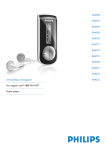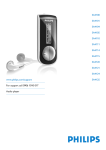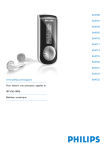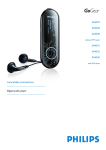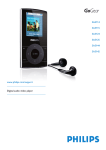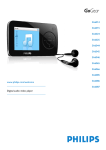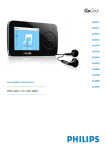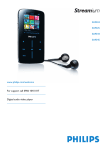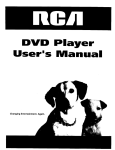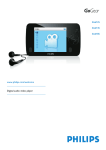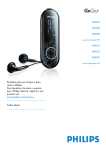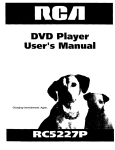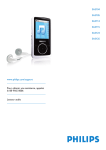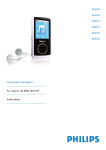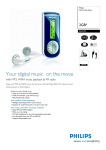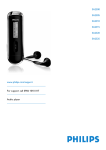Download Philips GoGear Flash audio player SA4126
Transcript
SA4126 SA4127 SA4146 SA4147 www.philips.com/welcome Audio player Need help? Please visit www.philips.com/welcome where you can access to a full set of supporting materials such as user manual, the latest software updates and answers to frequently asked questions 2 Contents 1 Important safety information 2 Your new player 2.1 2.3 3 3.1 3.2 3.3 3.3.1 3.4 3.5 3.5.1 3.5.2 4 4.1 4.1.1 4.1.2 4.1.3 4.1.4 4.2 4.2.1 4.2.2 4.2.3 4.2.4 4.3 4.3.1 4.3.2 4.3.3 4.3.4 4.3.5 4.3.6 4.4 4.4.1 4.4.2 4.4.3 4.4.4 What’s in the box Register your product Getting started Overview of controls and connections Install Connect Insert the battery Transfer Enjoy Power on and off Navigate the menu Organize and transfer music with Windows Media Player 11 About Windows Media Player 11 Before installing Windows Media Player 11 (optional) Installing Windows Media Player 11 Rolling back to a previous version of Windows Media Player More about rolling back to a previous version of Windows Media Player Music transfer 5 10 10 10 11 11 12 12 12 13 13 13 13 14 14 14 15 18 19 19 Add music files to Windows Media Player Library 20 Switch between music library in Windows Media Player and your player 21 Rip songs from a CD 22 Buy music online 24 Sync your Windows Media contents to your player Set up your player Switch Between Automatic and Manual Sync Select and Prioritise What Syncs Automatically Select files and playlists for Manual Sync Shuffle manual sync items on your player Copy files from your player to your computer Manage your Windows Media Player Playlist Create a regular Playlist Create an Auto Playlist Edit playlist Transfer playlists to your player 25 25 26 26 27 29 30 30 30 31 32 33 3 Contents 4.5 4.5.1 4.5.2 4.5.3 4.5.4 4.5.5 4.5.6 5 5.1 5.1.1 5.1.2 5.2 5.2.1 5.2.2 5.2.3 5.2.4 5.3 5.4 6 6.1 4 Manage your files and playlists in Windows Media Player 34 Search for music via Windows Media Player Delete files and playlists from Windows Media Player library Delete files and playlists from your player Add or change album art Edit song information via Windows Media Player Format your player via Windows Media Player Detail operation Music mode Control Playback features Recordings Make recordings Play back recordings Upload recordings to the computer Delete recordings Settings Use your player to store and carry data files Update your player Manually verify whether your firmware is up to date 34 34 34 35 36 37 38 38 38 39 40 40 40 40 40 41 41 42 42 7 Technical data 43 8 Frequently asked questions 44 9 Glossary 46 1 Important safety information General maintenance To avoid damage or malfunction: • Do not expose the player to excessive heat caused by heating equipment or direct sunlight. • Do not drop your player or allow objects to fall on your player. • Do not allow your player to be submerged in water. Do not expose headphone socket or battery compartment to water, as water entering the set may cause major damage. • Do not use any cleaning agents containing alcohol, ammonia, benzene, or abrasives as these may harm the set. • Active mobile phones in the vicinity may cause interference. • Backup your files. Please ensure that you retain the original files you have downloaded to your device. Philips is not responsible for any loss of data if the product becomes damaged or not readable / legible. • Manage (transfer, delete, etc.) your music files only with the supplied music software to avoid problems! About operating and storage temperatures • Operate in a place where temperature is always between 0 and 35ºC (32 to 95ºF) • Store in a place where temperature is always between -20 and 45ºC (-4 to 113ºF) • Battery life may be shortened in low temperature conditions. Replacements parts/ accessories Visit www.philips.com/support or contact our Customer Care Helpline (the telephone number can be found on the first page of this manual) to order replacement parts/ accessories. Hearing Safety Listen at a moderate volume. • Using headphones at a high volume can impair your hearing. This product can produce sounds in decibel ranges that may cause hearing loss for a normal person, even for exposure less than a minute. The higher decibel ranges are offered for those that may have already experienced some hearing loss. • Sound can be deceiving. Over time your hearing “comfort level” adapts to higher volumes of sound. So after prolonged listening, what sounds “normal” can actually be loud and harmful to your hearing. To guard against this, set your volume to a safe level before your hearing adapts and leave it there. To establish a safe volume level: • Set your volume control at a low setting. • Slowly increase the sound until you can hear it comfortably and clearly, without distortion. 5 Listen for reasonable periods of time: • Prolonged exposure to sound, even at normally “safe” levels, can also cause hearing loss. • Be sure to use your equipment reasonably and take appropriate breaks. Be sure to observe the following guidelines when using your headphones. • Listen at reasonable volumes for reasonable periods of time. • Be careful not to adjust the volume as your hearing adapts. • Do not turn up the volume so high that you can’t hear what’s around you. • You should use caution or temporarily discontinue use in potentially hazardous situations. • Do not use headphones while operating a motorized vehicle, cycling, skateboarding, etc.; it may create a traffic hazard and is illegal in many areas. Important (for models supplied with headphones): Philips guarantees compliance with the maximum sound power of its audio players as determined by relevant regulatory bodies only with the original model of provided headphones. In case this one needs replacement, we recommend that you contact your retailer to order a model identical to that of the original, provided by Philips. Copyright information All other brands and product names are trademarks of their respective companies or organizations. Unauthorized duplication of any recordings whether downloaded from the Internet or made from audio CDs is a violation of copyright laws and international treaties. The making of unauthorized copies of copy-protected material, including computer programmes, files, broadcasts and sound recordings, may be an infringement of copyrights and constitute a criminal offence. This equipment should not be used for such purposes. This product is protected by certain intellectual property rights of Microsoft Corporation. Use or distribution of such technology outside of this product is prohibited without a license from Microsoft or an authorized Microsoft subsidiary. Content providers are using the digital rights management technology for Windows Media contained in this device (“WM-DRM”) to protect the integrity of their content (“Secure Content”) so that their intellectual property, including copyright, in such content is not misappropriated. This device uses WM-DRM software to play Secure Content (“WM-DRM Software”). If the security of the WM-DRM Software in this device has been compromised, Microsoft may revoke (either on its own or upon the request of the owners of Secure Content (“Secure Content Owners”)) the WM-DRM Software’s right to acquire new licenses to copy, display and/or play Secure Content. Revocation may also prevent your device’s ability to transfer, store, copy, display and/or play Secure Content which you have previously stored on your Device. Revocation does not alter the WM-DRM Software’s ability to play unprotected content. A list of revoked WM-DRM Software is sent to your device whenever you download a license for Secure Content from the Internet or from a PC. Microsoft may, in conjunction with such license, also download revocation lists onto your device on behalf of Secure Content Owners, which may disable your device’s ability to copy, display and/or play Secure Content. 6 In the event of revocation, Philips will attempt to make available software updates to restore some or all of your device’s ability to transfer, store, access, copy, display and/or play Secure Content. However, the ability to make such updates available does not rest solely with Philips. Philips does not guarantee that, after revocation, such software updates will be available. If such updates are not available, your device will not have the ability to transfer, store, copy, display and/or play Secure Content - even Secure Content which you have previously stored on your device. In addition, even if such software updates are available, they may not enable your Device to transfer, store, copy, display, and/or play Secure Content which was previously stored on your Device. In some cases you may be able to transfer the content from the PC. In other cases, you may have to repurchase previously obtained Secure Content. To summarize - Microsoft, Secure Content Owners, and Secure Content distributors may deny you access, or restrict your access, to Secure Content. They may also disable your device’s ability to transfer, store, copy, display and/or play Secure Content even after you have paid for and obtained it. Neither your consent nor the consent or approval of Philips is necessary for any of them to deny, withhold or otherwise restrict your access to Secure Content or to disable your device’s ability to transfer, store, access, copy, display, and/or play Secure Content. Philips does not guaranty that you will be able to transfer, store, access, copy, display, and/or play Secure Content. The Windows Media and the Windows logo are registered trademarks of Microsoft Corporation in the United States and/or other countries. Data logging Philips is committed to improving the quality of your product and enhancing the Philips user experience. To understand the usage profile of this device, this device logs some info / data to the non-volatile memory region of the device. These data are used to identify and detect any failures or problems you as a user may experience while using the device. The data stored, for example, will be the duration of playback in music mode, duration of playback in turner mode, how many times battery low was encountered, etc. The data stored do not reveal the content or media used on the device or the source of downloads. The data stored on the device are retrieved and used ONLY if the user returns the device to the Philips service centre and ONLY to simplify error detection and prevention. The data stored shall be made available to user on user’s first request. 7 Disposal of your old product Your product is designed and manufactured with high quality materials and components, which can be recycled and reused. When this crossed-out wheeled bin symbol is attached to a product, it means the product is covered by the European Directive 2002/96/EC. Please be informed about the local separate collection system for electrical and electronic products. Please act according to your local rules and do not dispose of your old product with your normal household waste. The correct disposal of your old product will help prevent potential negative consequences to the environment and human health. Modifications Modifications not authorized by the manufacturer may void user authority to operate this device. 8 Notice for USA Note: This equipment has been tested and found to comply with Philips SA4126, SA4127, SA4146, SA4147 the limits for a Class B digital device, pursuant to part 15 of the FCC Rules. These limits are designed to provide reasonable protection against harmful interference in a residential installation. This equipment generates, uses, and can radiate radio frequency energy and, if not installed and used in accordance with the instruction manual, may cause harmful interference to radio communications. However, there is no guarantee that interference will not occur in a particular installation. If this equipment does cause harmful interference to radio or television reception, which can be determined by turning the equipment off and on, the user is encouraged to try to correct the interference by one or more of the following measures: - Relocate the receiving antenna. - Increase the separation between the equipment and receiver. - Connect the equipment into an outlet on a circuit different from that to which the receiver is connected. - Consult the dealer or an experienced radio/ TV technician for help. Notice for Canada This Class B digital apparatus complies with Canadian ICES-003. The set complies with the FCC-Rules, Part 15 and with 21 CFR 1040.10. Operation is subject to the following two conditions: • This device may not cause harmful interference, and • This device must accept any interference received, including interference that may cause undesired operation. Notice for the European Union This product complies with the radio interference requirements of the European Union. 9 2 Your new player With your newly purchased player, you can enjoy the following: • MP3, WAV and WMA playback • Voice recording 2.1 What’s in the box The following accessories are included with your player: Player Headphones Philips audio player USB cable Pouch SA4126 SA4127 SA4146 SA4147 Quick start guide EN FR ES DE NL Quick start guide Guide de démarrage rapide Guía de inicio rápido Kurzanleitungsanleitung Handleiding voor snel gebruik 1 10 19 28 37 IT PO RU PL HU Guida di riferimento rapido Início rápido Быстрый запуск Krótka instrukcja obsługi Gyors áttekintés 46 55 65 74 83 1 Install 2 Connect and charge 3 Transfer 4 Enjoy AAA battery Quick start guide CD-ROM containing Windows Media Player 11, Philips Device Manager, User Manual and Frequently Asked Questions 2.2 Register your product We strongly recommend that you register your product in order to gain access to free upgrades. To register your product, please log on to www.philips.com/welcome so that we can inform you as soon as new updates become available. 10 3 Getting started 3.1 Overview of controls and connections A p B C Display A B G H C D J( I J E )K D E F y / 2; F G REC H MENU/ K I Vol J Vol + K Headphones jack Microphone Dynamically display menu, options and track information Press to return to a previous song, press and hold to fast rewind. In menu mode, press to navigate through the menu. Press to skip to the next song, press and hold to fast forward. In menu mode, press to navigate through the menu. Power on/off and play/pause, confirm a menu setting Start or stop voice recording Press to access the menu / Return to previous menu Disable or enable the player’s controls Volume down volume up USB connector 11 3.2 Install Important Make sure to install the software provided in the supplied CD for music transfer. System requirements: • • • • • • • Windows XP (SP2 or higher) Pentium Class 300MHz processor or higher 128MB RAM 500MB hard disk space Internet connection (preferable) Microsoft Internet Explorer 6.0 or later USB port 1 Insert the CD supplied with your product into the CD ROM drive of your PC. 2 Follow the on-screen instructions to complete the installation of Windows Media Player and Philips Device Manager. 3 If the installation program does not start automatically, browse the CD contents with Windows Explorer and run the program by double clicking on the file ending with .exe. Lost your CD? Don’t worry, you can download the CD contents from www.philips.com/support. 3.3 Connect 3.3.1 Insert the battery 1 Remove the battery door by sliding it in the direction of arrow. 2 Insert the supplied AAA battery into the battery compartment. 3.3.2 Read the battery level indication of your player The approximate power levels of your battery are indicated as follows: Full Two-thirds full Half full Low Empty Note When the batteries are almost empty, the low battery screen blinks. Your player will power down in less than 60 seconds. Your player will save all settings and unfinished recordings before it powers down. 12 3.4 Transfer You can transfer music to your player using Windows Media Player. See Organize and transfer music with Windows Media Player 11 section of this user manual for more details. 3.5 Enjoy 3.5.1 Power on and off To power on, press 2; until the Philips welcome screen appears. To power off, press and hold 2; until there is no display on the screen. Tip Your player automatically powers down if there is no operation and no music played for 3 minutes. 3.5.2 Navigate the menu Your player has an intuitive menu navigation system to guide you through various settings and operations. Use J( and )K to browse through menus. Press 2; to confirm your selection. You can press MENU to access the menu and return to previous level. When your player powers up, you can see the Root menu. It includes: Music Recordings Settings Play your digital music tracks Play your recordings Change the playmode, equalizer, backlight or language settings, display the player information 13 4 Organize and transfer music with Windows Media Player 11 4.1 About Windows Media Player 11 While your player will work with Windows Media Player 10, we suggest that you use Windows Media Player 11 for a more enhanced media experience, both on the computer and on your player. Windows Media Player 11 is an all-in-one playback and recording program that lets you play your CDs, rip CD tracks to your hard disk, transfer media files to your player, etc. This chapter describes the steps that you need to follow to successfully set up and transfer music to your player. For more information, see Windows Media Player Help on your computer or visit www.microsoft.com/windows/windowsmedia/player/faq/default.mspx Important Make sure that you have installed the Windows Media Player 11 software provided in the by-packed CD for music transfer. You must be logged on as an administrator or a member of the Administrators group to perform the following procedures. For more information, please visit www.microsoft.com 4.1.1 Before installing Windows Media Player 11 (optional) If necessary, before you install Windows Media Player 11, go to Windows Update and install any high-priority updates that are available for your computer. Perform the following steps if you wish to save media information and star ratings to your media file, as well as back up your existing data: 1 In Windows Media Player 10, click Tools, and then click Options. 2 Click the Library tab, select the Maintain my star ratings as global ratings in the media files check box. > The user ratings for your songs will be saved in your media files rather than in your library database file (this may take several minutes). 3 Click Tools, and then click Process media information now. > This ensures that your ratings (and any changes that you have made to other media information) are saved to your media files immediately. 4 Select Start > All Programs > Accessories > System Tools > Backup to backup your existing data. 14 4.1.2 Installing Windows Media Player 11 1 Insert the by-packed CD into the CD ROM drive of your computer. Note If the installation program does not start automatically, browse the CD contents via Windows Explorer and run the program by double clicking on the file ending with .exe. 2 Follow the onscreen instructions to complete the installation of Windows Media Player 11. Note If the following dialog boxes appear during installation, read through the texts before you proceed with the installation: 3 Click Validate to continue. 15 4 Click I Accept to continue. 5 Select EXPRESS and click Finish. 16 Note Your existing media library is currently migrating to Windows Media Player 11. This may take several minutes depending on the size of your existing media library. 6 Click on the checkboxes to select the file types that you want Windows Media Player to play by default or click Select all and then click Finish. 17 7 Click on the checkboxes to select your privacy options and then click Next to complete the necessary settings. 4.1.3 Rolling back to a previous version of Windows Media Player If you encounter some problems with Windows Media Player 11, you can simply roll back to the version that was previously on your computer. 1 Disconnect your player from your computer. 2 Select Start, and then click Control Panel. 3 In the Control Panel, select Add or Remove Programs. 4 Select Windows Media Player 11, and then click Remove. > A confirmation dialog box appears. 5 Click OK. 6 When the rollback process is completed (this may take several minutes), click Restart. 7 Select Start, and then click Control Panel. 8 In the Control Panel, select Add or Remove Programs. 9 Select Windows Media Format 11 Runtime, and then click Remove. > A confirmation dialog box appears. 10 Click OK. > A second confirmation dialog box appears. 11 Click OK. 18 12 When the rollback process is completed (this may take several minutes), click Restart. 13 Select Start, and then click Control Panel. 14 In the Control Panel, select Add or Remove Programs. 15 Select Microsoft User-Mode Driver Framework Feature Pack 1.0, and then click Remove. 16 Follow the instructions that appear in the Software Update Removal Wizard. 17 If the Wudf01000 confirmation dialog box appears, click Yes to continue. When the software removal process is completed (this might take several minutes), click Finish. 4.1.4 More about rolling back to a previous version of Windows Media Player If you roll back to a previous version of Windows Media Player, and your player becomes undetectable by Windows or Windows Media Player, perform the following procedures: 1 Switch on your player and connect it to your computer using the supplied USB cable. 2 Right-click My Computer, and then click Manage. 3 In the left pane, click Device Manager. 4 In the right pane, click on the "+" sign beside Portable Devices. 5 Right-click GoGear SA41xx, and then click Uninstall. 6 In the confirmation dialog box, click OK to uninstall the player. 7 Disconnect your player from your computer, make sure it is still switched on, and then connect it to your computer again. > Windows will detect your device and automatically re-install it. Within a minute or two, GoGear SA41xx will reappear in the Portable Devices section of Device Manager. 4.2 Music transfer You can view and manage your music files using Windows Media Player. Important We recommend that you always use Windows Media Player to transfer music to your player. 19 4.2.1 Add music files to Windows Media Player Library By default, Windows Media Player automatically loads all the music files stored in your My Music folders into the library. If you add new files to these folders, they will also be automatically added to the library. Add music files that are stored elsewhere on your computer or computer network 1 Select Start > All Programs > Windows Media Player to launch Windows Media Player program. 2 Click the down arrow beneath the Library tab and select Add to Library ... > Add to Library dialog box appears. 3 Click <<Advanced Options to expand the dialog box. 20 4 Click Add... > Add folder dialog box appears. 5 Select a folder in which you have kept your music files and click OK. 6 Return to Add to library dialog box and click OK. > Windows Media Player will start scanning the folder and add available music files to the library. 7 Click Close when done. Tip Windows Media Player is configured to skip audio files that are smaller than 100KB. To include files smaller than 100KB, you can change the default settings within the Add to library dialog box. 4.2.2 Switch between music library in Windows Media Player and your player To switch between music library, simply click the arrow on the top left of Windows Media Player and select the category you want to view. 21 4.2.3 Rip songs from a CD If you want to transfer music from a CD to your player, you need to create a digital copy of the music on your computer first. This is called Ripping. 1 Start Windows Media Player. 2 Click the down arrow beneath the Rip tab and select Format to choose the format you want. 3 Click the down arrow beneath the Rip tab and select Bit Rate to choose the bit rate you want. Tip A higher bit rate produces a better sound quality, but the file size will be larger. The recommended format for yourplayer is 128kbps MP3 or 64kbps WMA. 22 4 Insert the Audio CD into your computer's CD drive. > All the tracks from the CD are listed. By default, Windows Media Player will start to rip all the songs in the CD. To modify this option, click the down arrow beneath the Rip tab and select Rip CD Automatically When Inserted > Never. Important Make sure that you are connected to the Internet before you start ripping so that Windows Media Player can download the album and track information from an online music database. If your computer is not connected to the Internet, you will have to enter the album and track information manually. As Windows Media Player may not always identify the right song on the CD and the online music database may not always have the correct information (especially for new album releases or albums from lesser-known artists), you may need to manually edit or enter the album and track information. See Edit song information via Windows Media Player. 23 5 Select the songs that you want to rip by clicking on the checkboxes. 6 Click Start Rip. > The selected tracks will be converted and added to Windows Media Player library. 4.2.4 Buy music online If you want to buy music online, you need to select a music store. 1 Start Windows Media Player. 2 Click the down arrow beneath the Media Guide tab and select Browse all Online Stores. 3 Choose a store and follow the on-screen instructions. 24 Note Depending on where you are and the language used, the list of stores may differ from what is shown here. > After you have bought a song or an album, it will appear in Windows Media Player library. 4.3 Sync your Windows Media contents to your player You can sync your music to your player using Windows Media Player. Simply connect your player to your computer using the supplied USB cable, set up sync, and you will be ready to sync your media library to the player. When you connect your player to the computer for the first time, Windows Media Player automatically selects the sync method (automatic or manual) that works best for your player. Automatic: If your player has sufficient storage space (at least 4GB of free space) and your entire media library can fit on your player, your entire media library will be automatically copied to your player as soon as you connect it to your computer. Manual: If your entire media library cannot fit on the player, then you will be prompted to manually select specific files or playlists that you want to transfer to your player. 4.3.1 Set up your player 1 Start Windows Media Player. 2 Switch on your player and then connect it to your computer using the supplied USB cable. > If prompted, select the option to sync the device using Windows Media Player. 3 If Windows Media Player selects to sync your device automatically, click Finish. > Your entire library will sync to your player. Thereafter, every time you connect your player to your computer, your player will sync automatically. You can also select and prioritise what syncs automatically (see Select and Prioritise What Syncs Automatically). 4 If Windows Media Player selects to sync your device manually, click Finish. > You then need to click the Sync tab and select the files and playlists you want to sync manually (see 4.3.4 Select files and playlists for Manual Sync). Important Do not disconnect your player while transferring is in progress. If you disconnect your player, the transfer will not be complete and Windows might not be able to recognize your player afterwards. To rectify this problem, perform steps 1 - 7 in 4.1.4 More about rolling back to a previous version of the Player. 25 4.3.2 Switch Between Automatic and Manual Sync After your player is set up the first time, depending on your preference, you can switch between automatic and manual sync. 1 Click the down arrow beneath the Sync tab, select Philips GoGear SA41xx > Set Up Sync. 2 Select or clear the Sync this device automatically check box. 4.3.3 Select and Prioritise What Syncs Automatically If Windows Media Player has selected to sync your device automatically, you can choose not to sync your entire media library. You can choose what you wish to sync from existing playlists or create new playlists. These playlists you have selected will then sync to your player every time you connect it to your computer. 1 Click the down arrow beneath the Sync tab and select Philips GoGear SA41xx > Set Up Sync. > The Device Setup dialog box appears. 2 In the Available playlists pane, select the existing playlists you want to sync and then click Add. 26 3 To create a playlist, click New Auto Playlist and follow the steps on the screen to specify criteria for files in the auto playlist (for details on how to create an auto playlist, see 4.4.2 Create an Auto Playlist). 4 To remove a playlist, click the playlist in the list of Playlists to sync, and then click Remove. 5 In the Playlists to sync pane, select a playlist and click the Priority arrows to arrange them in the order that you want them to sync. > If your player is full before sync is complete, then the files and playlists that are lower in priority on the list will not sync. Tip If your player has limited storage capacity, or if your media library has grown too large to fit on your player, you can shuffle the files that are in the playlists you have selected to sync. To do so, select the Shuffle what syncs check box. Thereafter, every time you connect your player to the computer, the files on your player are removed and a new set of files (from the Playlists to sync pane) are added to the device. 4.3.4 Select files and playlists for Manual Sync If you sync manually, you must create a list of files and playlists you want to sync. You can also shuffle which files from your playlists to sync to your player. 1 Start Windows Media Player. 2 Switch on your player and then connect it to your computer using the supplied USB cable. 3 Click the Sync tab. 4 Drag the files and playlists that you want to sync from the Contents pane to the Sync List pane. You can also right-click on the file or playlist and select Add to "Sync List". Tip To switch between music and photos library, simply click the arrow on the top left of Windows Media Player and select the category you want to view. 27 5 In the Sync List pane, verify that the items you have selected to sync will all fit on your player. If necessary, remove items from the list. 6 To remove items, right-click on the item in the Sync List pane, and then select Remove from List. 7 Click Start Sync button to transfer the Sync List items to your player. > The progress is displayed on the bottom right of Windows Media Player. Tip If the track you are trying to sync is a protected file, you will be prompted to upgrade the security components on your computer. When this happens, play the track in Windows Media Player and when prompted, follow the steps on the screen to upgrade the security components. After you have upgraded your security components, sync the file to your player again. 28 8 If you wish to stop the transfer, click Stop Sync. Tip To select multiple files, click on one file, then press and hold the CTRL key on your computer keyboard and click the other files that you want to select. To select consecutive files, click on the first file, then press and hold the SHIFT key on your computer keyboard and click the last file in the list that you want to select. To select all files, click on any file to highlight it, then press and hold CTRL + A key on your computer keyboard. 4.3.5 Shuffle manual sync items on your player The Shuffle Sync feature in Windows Media Player is able to detect the amount of space in your player and load your player with a random sampling of files. 1 Start Windows Media Player. 2 Switch on your player and then connect it to your computer using the supplied USB cable. 3 Click the down arrow beneath the Sync tab and select Shuffle "Philips GoGear SA41xx". 4 If prompted, click Yes button to start synchronization. Otherwise synchronization starts immediately. > The progress is displayed on the bottom right of Windows Media Player. 5 To stop Sync, click the down arrow beneath the Sync tab and select Stop Sync to "Philips GoGear SA41xx". 29 4.3.6 Copy files from your player to your computer Your player supports reverse sync, which lets you copy files from your player to your computer via Windows Media Player. 1 Start Windows Media Player. 2 Switch on your player and then connect it to your computer using the supplied USB cable. 3 Click on Philips GoGear SA41xx in the left Navigation pane. > You can browse your player's contents in a variety of views, such as Recently Added, Artist, Album, Songs, etc. The contents on your player will be listed in the Contents pane. Tip To switch between music and photos library in your player, simply click the arrow on the top left of Windows Media Player and select the category you want to view. 4 Navigate to the file or playlist you wish to copy from your player to your computer. 5 Right-click on the file or playlist and select Copy from Device. 4.4 Manage your Windows Media Player Playlist Playlists allow you to mix any combination of songs or photos you want so that you can enjoy hours of listening or viewing. You can create regular or auto playlists containing songs, photos or both using Windows Media Player 11. 4.4.1 Create a regular Playlist 1 Click the down arrow beneath the Library tab and select Create Playlist. > Untitled Playlist appears on the List pane 30 2 Click on Untitled Playlist and enter a new name for the playlist. 3 To add items to your playlist, drag them from the Contents pane onto the List pane. Your playlist can contain both songs and photos. Tip To switch between music and photos library in your player, simply click the arrow on the top left of Windows Media Player and select the category you want to view. 4 When you have finished adding items to the playlist, click Save Playlist. 4.4.2 Create an Auto Playlist Windows Media Player can automatically generate playlists based on various criteria. 1 Click the down arrow beneath the Library tab and select Create Auto Playlist. > A New Auto Playlist dialog box appears. 31 2 Enter a name for the auto playlist. 3 Click the first green plus sign and select your first criteria from the pull-down list. > Your criteria is listed. 4 Click on the underlined words to further define your criteria. 5 Click the second and third green plus signs to select and define more criteria for your auto playlist. 6 Click OK button when done. 4.4.3 Edit playlist You can edit your existing playlists at any time. 1 Click on Playlists in the left Navigation pane. > All your playlists will be displayed in the Contents pane. 32 2 Right-click on the playlist you wish to edit and select Edit in List Pane from the pop-up menu. > The contents in the playlist appears on the List pane. 3 To remove an item from the playlist, right-click on the item and select Remove from List. 4 To change the order of the items in the playlist, click and drag any item to a new position within the List pane. 5 To add a new item to the playlist, select it from the library and drag it to the List pane. 6 When you have finished editing the playlist, click Save Playlist button. 4.4.4 Transfer playlists to your player Refer to 4.3.4 Select files and playlists for Manual Sync. 33 4.5 Manage your files and playlists in Windows Media Player 4.5.1 Search for music or photos via Windows Media Player 1 Click the Library tab. 2 To search for music files, click the arrow on the top left of Windows Media Player and select Music. 3 Type a few keywords of the file, such as song title, artist, etc in the search box. > The results of your search appear in the Contents pane as you type, and are updated as you enter each new letter of your search. 3 Keep entering the keywords to fine-tune the results of your search. 4.5.2 Delete files and playlists from Windows Media Player library 1 Click the Library tab. 2 To delete music files, click the arrow on the top left of Windows Media Player and select Music. 3 Navigate to the file or playlist you wish to delete. 4 Right-click on the file or playlist and select Delete. 5 Select Delete from library only or Delete from library and my computer and click OK. 4.5.3 Delete files and playlists from your player You can also use Windows Media Player to manage the files stored on your player. When you connect your player to the computer, the contents on your player will be displayed in Windows Media Player. You can then delete files or playlists, just as you would any other files displayed in Windows Media Player. 1 Click on Philips GoGear SA41xx in the left Navigation pane. > You can browse your player's contents in a variety of views, such as Recently Added, Artist, Album, Songs, etc. The contents on your player will be listed in the Contents pane. 2 To delete music files, click the arrow on the top left of Windows Media Player and select Music. 34 3 Navigate to the file or playlist you wish to delete. 4 Right-click on the file or playlist and select Delete. 5 Click OK. 4.5.4 Add or change album art 1 Locate and store your album art (preferably in JPG format) on your computer. 2 Right-click on the album art and select Copy. 3 Go to Windows Media Player and locate the album that you wish to add or change the album art. 4 Right-click on the album and select Paste. > The new album art now appears on your album in Windows Media Player. Tip You can search for album art using Google Image Search (images.google.com) 35 4.5.5 Edit song information via Windows Media Player 1 Click the Library tab. 2 Navigate to the song you wish to edit. 3 Right-click on the song and select Advanced Tag Editor from the pop-up menu. > The Advanced Tag Editor dialog box appears. 4 Select the appropriate tab and enter or edit the information. 5 Click OK to save your changes. 36 4.5.6 Format your player via Windows Media Player You can reformat the hard disk on your player to erase all data. 1 Start Windows Media Player. 2 Switch on your player and then connect it to your computer using the supplied USB cable. 3 Click the down arrow beneath the Sync tab and select Philips GoGear SA41xx > Format. 37 5 Detail operation 5.1 Music mode (also applicable to playback of recordings) 5.1.1 Control You can do the following action during music playback: To Do this Play / Pause music Press 2; Skip to next song Press )K Return to previous song Press J( Fast forward Press and hold )K Fast rewind Press and hold J( Return to browsing menu Press MENU key Increase volume Press VOL + Decrease volume Press VOL From the main menu, select to enter music mode. You can search from the following music options: All songs Alphabetically listed tracks Artists Alphabetically listed artists Albums Alphabetically listed albums Playlists Playlists collections 38 5.1.2 Playback features Play modes You can set your player to play songs either randomly or repeatedly. 1 Press MENU, select Settings and then select Play modes. 2 Press J( / )K to browse through the different play modes (Off, Repeat 1, Repeat all and Shuffle all). 3 Press 2; to confirm your selection. Icon Meaning Off Normal playback Repeat 1 Play one song repeatedly Repeat all Play all songs repeatedly Shuffle all Play all songs randomly and repeatedly Note Playmodes are not available when playing recordings. Sound settings You can set your player to play music with different EQ (equalizers). 1 Press MENU, select Settings, then select Sound settings. 2 Press J( / )K to select between Pop, Jazz, Rock , Classical or Off. 3 Press 2; to confirm your selection. 39 5.2 Recordings Your player allows you to make voice recordings and play back your recordings. 5.2.1 Make recordings 1 Press and hold REC to start voice recording. > Your player displays the recording progress. 2 Press and hold REC again to stop voice recording > Your player displays the saving progress. Your voice recording will be saved on your player. (Filename format: VOICEXXX.WAV where XXX is the recording number which will be automatically generated.) Tip You can pause and resume a recording anytime with 2; key. 5.2.2 Play back recordings You can find your recordings in the Recordings mode. 1 From the root menu, select to enter the Recordings mode. Your player will play all your recordings alphabetically and playback will start with the last recording made. 2 Press 2; to pause the recording on playback. 3 Press J( or )K to play the next or previous recordings. 4 Press and hold J( or )K to fast forward or fast rewind the current recording on playback. 5.2.3 Upload recordings to the computer 1 Connect your player to your computer. 2 Select your player in Windows Explorer. > You will find a Voice folder. This folder contains the recordings. 3 Copy and paste the recordings to any desired location on the computer. 5.2.4 Delete recordings Recordings can only be deleted on the computer. 1 Connect your player to your computer. 2 Select your player in Windows Explorer. 3 Double click the Voice folder. 4 Select the files you want to delete and press Delete on your computer keyboard. 40 5.3 Settings You can set your preferences in your player to suit your needs. 1 Press MENU and select SETTINGS. 2 Press J( / )K to browse through the various options and press 2; to confirm your selection. 3 Press MENU to exit the current settings screen. Settings Play mode Sound settings Language Backlight Information Further Options Off / Repeat 1 / Repeat all / Shuffle all Pop / Rock / Jazz / Classical / Off English / French / German / Spanish / Brazilian Portuguese / Portuguese / Italian / Dutch / Swedish / Norwegian / Finnish / Hungarian / Russian / Polish / Chinese Simplified / Chinese Traditional / Japanese / Korean Timer: 10 sec / 30 sec / Always on / Off Colour: White / Red / Yellow / Green / Blue / Purple / Cobalt / Random FW (Firmware) version / Free space 5.4 Use your player to store and carry data files You can use your player to store and carry data files by copying data files into the Data folder of your player via Windows Explorer. Note Data files stored in the Data folder cannot be read directly from your player. These data files can only be read in your computer after you transfer them from your player to your computer. 41 6 Update your player Your player is controlled by an internal program called the firmware. Newer versions of the firmware may have been released after you have purchased your player. A software program called Philips Device Manager enables you to update the firmware on your device if a new firmware is available on your PC. Install Philips Device Manager from the supplied CD or download the latest version from www.philips.com/support After the installation of Philips Device Manager, every time you connect your player to your computer, Philips Device Manager will automatically connect to the Internet and check for updates. 6.1 Manually verify whether your firmware is up to date 1 Connect your player to the computer. 2 Launch Philips Device Manager from Start > Programs > Philips Device Manager. 3 4 5 3 Select your device. 4 Click Update. > Philips Device Manager will check whether a new firmware is available on the Internet and install it on your player. 5 When Update completed appears on the screen, click OK and disconnect the player. > A message Updating firmware will be displayed. The player will automatically restart after firmware is completely updated. Your player is now ready to use again. 42 7 Technical data Power • Power supply: AAA alkaline battery* Connectivity • Headphone 3.5mm, USB 2.0++ Display • Picture / Display: Mono display, 32 x 128 pixels Music transfer • Drag and drop in Windows Explorer Sound • Channel separation: 45dB • Equalizer settings: Rock / Jazz / Pop / Classical / Off • Frequency response: 30-18000Hz • Signal to noise ratio: > 85dB • Output Power (RMS): 2x3mW (European Union countries) 2x29mW (non-European Union countries) System Requirements • Windows® XP (SP2 or higher) • Pentium Class 300MHz processor or higher • 128MB RAM • 500MB hard disk space • Internet connection • Microsoft Internet Explorer 6.0 or later • Video display card • Sound card • USB port Audio Playback • Compression format: MP3 (32-320 kbps and VBR; Sample rate: 8, 11.025, 16, 22.050, 24, 32, 44.1, 48kHz), WMA (64-320kbps) • ID3-tag support: Song title and artist name Recording • Audio Capturing: Built-in microphone (Mono) Storage Media • Built-in memory capacity: SA412X 2GB NAND Flash + SA414X 4GB NAND Flash + * Battery life vary by use and settings. + 1MB = 1 million bytes; available storage capacity will be less. 1GB = 1 billion bytes; available storage capacity will be less. Full memory capacity may not be available as some memory will be reserved for the player. Storage capacity based on 4 minutes per song and 64kbps WMA encoding. ++ Actual transfer speed may vary based on your operating system and software configuration. 43 8 Frequently asked questions If you encounter problems with your player, go through the following points listed in the next section. Please also check out FAQs at www.philips.com/support for further help and other troubleshooting tips. Consult your dealer or service center if you are unable to find a solution by following these hints. Warning Under no circumstances should you try to repair the set yourself, as this will invalidate the warranty. My player skips songs. The skipped song may be protected. You may not have sufficient rights to play the skipped song on your player. Check the music rights with the song provider. My player is not recognized by Windows. Make sure your computer is running Windows XP (SP2 or higher). My player has no power or is locked up. • Your battery may have gone flat. Insert a new battery before use. • You may have failed to press and hold 2; long enough. Press and hold 2; until the Philips welcome screen appears on display. • Do a soft reset by re-inserting the battery. If none of the above works, then you may have to use the Device Manager to recover your player: 1 Make sure the player is disconnected from PC and turned off. 2 Launch the Philips Device Manager at Start > Programs > Philips Device Manager > Philips Device Manager on your PC and click Repair tab. 3 Press and hold the )K button while your player is connecting to the PC. 4 Keep holding the key until the Philips Device Manager acknowledges your player and goes into recovery mode. 5 Click the repair button and follow the instructions given by the Device Manager. 6 After the player has been repaired, disconnect it from your PC and re-start. Important When the first time you connect the device to PC in recovery mode, a hardware wizard will be popped up to install the software. Please select install the software automatically and click Next, and then click Finish to complete the installation. During the installation, a warning message stating "The Software you are installing for this hardware has not passed Windows Logo testing.", please select Continue Anyway, this installation will not affect your PC. 44 There is no music on my player after transfer. Are your songs in MP3 or WMA format? Other formats will not playback on the player. The player does not respond to any key press, and subsequently hangs or freezes. Remove and insert the battery again. There is no sound. Make sure your headphones are inserted all the way into the headphones jack. My player shows . Switch LOCK slider to unlock the key press. The player does not power on and seems dead. Insert a new battery. Press 2; and power up your player. In case this does not work: Press and hold 2; while connecting the device to the PC. Start Device Manager, your device will be recovered automatically. The player displays: “Player problem! Connect to PC”. Connect your player to the PC, open Windows Explorer, open My computer, select your player, right click and select on Format. Press Start to format your player. Warning All contents will be erased. Backup your data before formatting. The player shows . Connect your player to the computer. Delete unwanted files, disconnect safely and proceed with your record again. Some songs do not show up or playback on the player. • The audio file might be corrupted, try to playback the file on your PC first. If it does not play, rip the song again. • Songs with bit rates higher than 320kbps are not supported by the player. • The skipped song may be protected. You may not have sufficient rights to play the skipped song on your player. Check the music rights with the song provider. 45 9 Glossary A Album A collection list of songs. D Digital Rights Management (DRM) A technology that provides a persistent level of protection to digital content by encrypting it with a cryptographic key. Authorized recipients (or end users) must acquire a license in order to unlock and consume the content. M MP3 An audio compression format known as MPEG-1 Audio Layer 3. P Playlist A list of digital media contents. R Root menu The main menu that sits on top of the user interface structure tree. S Songs An individual track or a discrete piece of audio content. T Title The largest unit of digital media content. For CD, it may be the name of the CD. W WAV A digital media file format for storing sound. Windows Media Audio (WMA) An audio file in Windows Media Format. The audio content of the file is encoded with one of the Windows Media Audio codecs. 46 PHILIPS reserves the right to make design and specification changes for product improvement without prior notice. 47 abc Specifications are subject to change without notice. Trademarks are the property of Koninklijke Philips Electronics N.V. or their respective owners © 2007 Koninklijke Philips Electronics N.V. All rights reserved. www.philips.com Printed in China wk7241
















































